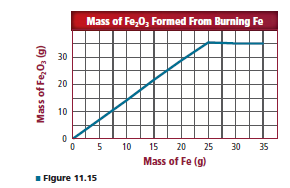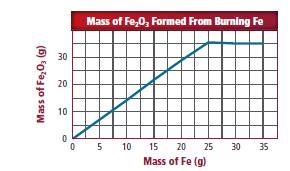
Iron reacts with oxygen as Shown.
Different amounts of iron were burned in a fixed amount of oxygen. For each mass of iron burned, the mass Of iron(lll) oxide formed was plotted on the graph shown Figure 11.15. Why does the graph level off after 25.0 g of iron is burned? How many moles of oxygen are present in the fixed amount?

Interpretation:
In the given graph, the reason for the level of the graph to be off after 25 g of iron needs to be explained. The number of moles of oxygen present in a fixed amount needs to be determined.

Concept Introduction: Iron reacts with oxygen to produce iron oxide.
Explanation of Solution
A linear increase in the graph suggests Fe2 O3 was produced according to the mass of iron. Up to 25 g of iron is present in fewer amounts. But, after that, oxygen which is present in a fixed amount is not enough to convert the remaining amount of iron to iron oxide. After this point, oxygen acts as a limiting reactant. This is the reason why there is an off on the graph level.
At point 25 g, iron oxygen is present in a sufficient amount. So at this point, the number of moles of oxygen can be calculated.
For that
Step 1: Write a balanced chemical equation
Step 2: Convert the mass of reactant to moles
Step 3: Convert moles of iron to moles of oxygen required using mole ratio
4 mole of Fe require = 3 moles of O2
1 mole of Fe requires
0.447 mole of Fe requires =
Step 4: Convert moles of oxygen to mass
Chapter 11 Solutions
Glencoe Chemistry: Matter and Change, Student Edition
Additional Science Textbook Solutions
Genetic Analysis: An Integrated Approach (3rd Edition)
Biology: Life on Earth (11th Edition)
Organic Chemistry (8th Edition)
Microbiology: An Introduction
Human Anatomy & Physiology (2nd Edition)
Concepts of Genetics (12th Edition)
- Consider the structure of 1-bromo-2-fluoroethane. Part 1 of 2 Draw the Newman projection for the anti conformation of 1-bromo-2-fluoroethane, viewed down the C1-C2 bond. ✡ ぬ Part 2 of 2 H H F Br H H ☑ Draw the Newman projection for the gauche conformation of 1-bromo-2-fluoroethane, viewed down the C1-C2 bond. H F Br H Harrow_forwardPlease help me answer this question. I don't understand how or where the different reagents will attach and it's mostly due to the wedge bond because I haven't seen a problem like this before. Please provide a detailed explanation and a drawing showing how it can happen and what the final product will look like.arrow_forwardWhich of the following compounds is the most acidic in the gas phase? Group of answer choices H2O SiH4 HBr H2Sarrow_forward
- Which of the following is the most acidic transition metal cation? Group of answer choices Fe3+ Sc3+ Mn4+ Zn2+arrow_forwardBased on the thermodynamics of acetic acid dissociation discussed in Lecture 2-5, what can you conclude about the standard enthalpy change (ΔHo) of acid dissociation for HCl? Group of answer choices You cannot arrive at any of the other three conclusions It is a positive value It is more negative than −0.4 kJ/mol It equals −0.4 kJ/molarrow_forwardPLEASE HELP URGENT!arrow_forward
 ChemistryChemistryISBN:9781305957404Author:Steven S. Zumdahl, Susan A. Zumdahl, Donald J. DeCostePublisher:Cengage Learning
ChemistryChemistryISBN:9781305957404Author:Steven S. Zumdahl, Susan A. Zumdahl, Donald J. DeCostePublisher:Cengage Learning ChemistryChemistryISBN:9781259911156Author:Raymond Chang Dr., Jason Overby ProfessorPublisher:McGraw-Hill Education
ChemistryChemistryISBN:9781259911156Author:Raymond Chang Dr., Jason Overby ProfessorPublisher:McGraw-Hill Education Principles of Instrumental AnalysisChemistryISBN:9781305577213Author:Douglas A. Skoog, F. James Holler, Stanley R. CrouchPublisher:Cengage Learning
Principles of Instrumental AnalysisChemistryISBN:9781305577213Author:Douglas A. Skoog, F. James Holler, Stanley R. CrouchPublisher:Cengage Learning Organic ChemistryChemistryISBN:9780078021558Author:Janice Gorzynski Smith Dr.Publisher:McGraw-Hill Education
Organic ChemistryChemistryISBN:9780078021558Author:Janice Gorzynski Smith Dr.Publisher:McGraw-Hill Education Chemistry: Principles and ReactionsChemistryISBN:9781305079373Author:William L. Masterton, Cecile N. HurleyPublisher:Cengage Learning
Chemistry: Principles and ReactionsChemistryISBN:9781305079373Author:William L. Masterton, Cecile N. HurleyPublisher:Cengage Learning Elementary Principles of Chemical Processes, Bind...ChemistryISBN:9781118431221Author:Richard M. Felder, Ronald W. Rousseau, Lisa G. BullardPublisher:WILEY
Elementary Principles of Chemical Processes, Bind...ChemistryISBN:9781118431221Author:Richard M. Felder, Ronald W. Rousseau, Lisa G. BullardPublisher:WILEY





